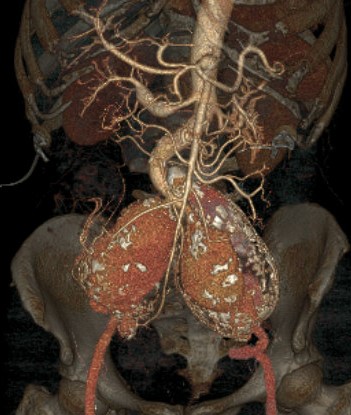Walking Pain with an Unusual Etiology
Thomas A. Sorrentino, BS, Devin S. Zarkowsky, MD, Charles M. Eichler, MD.
UCSF, San Francisco, CA, USA.
Demographics
The patient was a 78 year old woman with hypothyroidism and a 10 pack year smoking history who presented with bilateral back and flank pain radiating up her back and down her legs.
History
The patient reported her pain had been present for four months but in the two weeks prior to presentation she was unable to walk more than a few steps and required assistance standing from a seated position. Physical exam was notable for a pulsatile mass in the lower abdomen. CTA of the chest, abdomen, and pelvis revealed common iliac artery aneurysms extending into the external and internal iliac arteries, measuring 12.3 x 7.8 x 7.5cm on the left and 8.0 x 6.8 x 9.5cm on the right (Fig 1). The inferior mesenteric artery was widely patent and the aorta distal to the IMA was relatively free of atherosclerotic disease. Bilateral hydroureter was also noted.
Plan
The patientís tortuous anatomy and aneurysmal involvement of the internal and external iliac arteries precluded endovascular therapy, so we proceeded with an open repair. The aorta was controlled and divided immediately distal to the IMA, and a 14x7 bifurcated Dacron graft was anastomosed in an end-to-end fashion to the aorta. The aneurysms were opened and evacuated, and the internal iliac arteries were then oversewn from inside each aneurysm. Finally, the distal limbs of the graft were sewn to the non-aneurysmal portion of the external iliac arteries in an end-to-side fashion. The patientís post-operative course was complicated by volume overload and hospital-acquired pneumonia, but she was ultimately discharged home. At the one month post-operative appointment, the patient was ambulating without pain.
Discussion
Complex endovascular repair for bilateral common iliac artery aneurysms has become excellent option for those patients with amenable anatomy, but open surgery remains universally applicable from a technical standpoint, even in the most dilated and tortuous aneurysms. 
Figure 1. 3D reconstruction of the sub-diaphragmatic arterial vasculature demonstrating large bilateral common iliac artery aneurysms.
Back to 2019 ePosters
